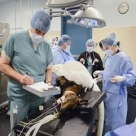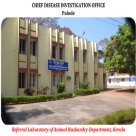Online Articles
Dr. Baby Joseph, Assistant Director,
19 - Sep - 2016
EM SOLUTION IN ANIMAL HUSBANDRY

EM SOLUTION IN ANIMAL HUSBANDRY
Dr. Baby Joseph, Assistant Director
Department of Animal Husbandry
EM Solution is a comparatively new concept in organic farming and is now widely used in various agricultural activities. It is used in animal husbandry activities. It is used as a deodorant and feed additive with beneficial results.
E.M. is an abbreviation for Effective Microorganisms. Microorganisms are tiny units of life that are too small to be seen with the naked eye and they exist everywhere in nature. Microorganisms are crucial for maintaining the ecological balance. They carry out chemical processes that make it possible for all other organisms including humans to live. There are friendly guys of the microbial worlds known as beneficial microorganisms and a not so friendly group called pathogens that are harmful and capable of producing disease, decay and pollution.
- In 1982 Dr.Higa at the University of Ryukyus, Okinawa Japan, discovered a specific group of naturally occurring beneficial microorganisms with an amazing ability to revive, restore, and preserve. He named this group E.M. (Effective microorganisms).
- EM is the trade mark used to identify this particular mixture of beneficial organisms
- E.M. is a combined culture of aerobic and anaerobic microorganisms that co-exist together to the mutual advantage of both (symbiosis).
- E.M combines with the existing microorganisms within the soil. They work together to build a healthy living soil.
- E.M is not toxic or pathogenic and is safe for humans, animals and the environment.
Current research indicates that EM cultures can suppress soil-borne pathogens, accelerate the decomposition of organic wastes, increase the availability of mineral nutrients and useful organic compounds to plants and animals, enhance the activities of beneficial micro-organisms, e.g., mycorrhizae, nitrogen fixing bacteria, and reduce the need for chemical fertilisers and pesticides. EM helps to increase beneficial soil micro-organisms and supression of harmful ones.
Presently it is widely used as an organic preparation with different dilutions and activation procedures mainly for the following purposes.
- Insect / Ectoparasite repellent
- Soil revitalize
- Foliage application
- Quick composting and waste disposal
- Animal husbandry activities.
Uses and Activation in Animal Husbandry
EM stock solution (Maple EM.1) is the dormant version of EM. It has a shelf life of twelve months and is dark brown in colour. EM stock solution needs to be “extended” or “activated” prior to use.
Extension implies the following materials and steps: One liter of Maple EM.1 and 1 kg or 1 liter of organically grown jaggery (or molasses) are to be mixed with 20 liters of water. The water has to be clean and free from chlorine. The container should be of food-grade plastic. (Glass or metal containers are not appropriate as the development of gas may cause the container to break or explode.). It should be clean, not contaminated with chemicals, and have an airtight lid. Between the mixed liquid and the lid only little air space should be left. As gas will develop during the fermentation, the lid will have to be opened once a day to release the pressure.
For the period of activation, in tropical regions such as Kerala, the container has to be placed in shade at ambient temperatures (20-40 degrees Celsius) without exposure to strong temperature fluctuations. Depending on actual ambient temperatures, extended EM (AEM) will be ready after five to seven days: AEM has a pleasant sweet-sour smell and a pH of about 3.5 (below 4).
Thus, from one liter of EM stock solution and one kg of jaggery, you can produce 22 liters AEM ready for use. In hygiene, AEM is being used full strength or in dilution with water up to 1:100; in farming in dilutions ranging from 1:200 to 1:1,000; and in wastewater treatment diluted (with effluent or sewage) up to several thousand times.
As the ideal microbial composition of AEM will deteriorate over time, it should be used within one month. Users are advised to prepare only so much of AEM as can be used within one month. EM stock solution should be extended only once.
EM stock solution can also be extended with the help of rice water and sugar. In kitchens and canteens where large amounts of rice are washed every day, or in places where molasses and jaggery are not readily available, the water used for the washing of rice can be used for the activation of EM stock solution. Collect the water of the first two or three washings of rice. Then Mix 3 volume parts of Maple EM.1 and 2 volume parts of sugar with 95 volume parts of the rice water. Store the mixture in an air-tight plastic container and deal with it in the same fashion as said for jaggery-based AEM.
Rice wash AEM is used in the same way as jaggery-based AEM. It has the advantage of being white in colour and hence is more readily accepted in the context of hygiene management.
Activated EM is used as deodorant in poultry, piggery, rabbit and other farms in Kerala. Animal Husbandry wing of Krishi Vijyan Kendra, CMFRI, Kochi had conducted various field trials on usage of AEM in AH and their observations were summarized as follows.
- Use of EM solution for de-odorizing animal sheds: This programme was implemented in selected farmer’s fields at Aluva, Thrikkakara and Thevara. There was slight odor reduction in dairy sheds while promising results have been obtained in case of rabbit sheds. When EM solution was used in drinking water, it was found to be effective by acting as probiotic in dairy animals and thus helped in increasing the fat content and milk yield. Its use is also found to increase the gas production in biogas unit. From this FLD, EM can be effectively used in odor reduction in rabbit sheds whereas it can be used as a probiotic in dairy animals
- Use of EM solution for deodorizing poultry sheds: This FLD was done in different areas of Kochi Corporation. Addition of EM solution in drinking water of the birds and spraying near the cages, floor and bedding material helped in odor reduction in these units. So use of EM solution will help to reduce the odor problem and thus promote rearing of poultry birds in urban areas.
Availability of EM Stock Solution
In India, Maple Orgtech (india) ltd, Kolkata are the sole licensed manufacturers of authentic EM as developed by Dr. Teruo Higa, Okinawa, Japan. Dr. Higa has clearly expressed his views on copies of the product in several countries and on the use of the term “Effective Microorganisms” by other manufacturers. Accordingly Maple had developed several EM1 solutions for different uses. But agricultural EM1 can be used for AH purposes and is freely available in all pesticide shops. Activated EM is prepared and marketed by Khadhi Village Industries and many Non Government Organisations in AH field.
Specific Maple EM1 for cattle, PASHUAMRUT is available in 1litre (Rs 413/-) and 5 litre (Rs 2032/-) and their Feed additive ANIMAL BAKSHI in1 kg packs (Rs 102/-). Current details and price can be verified in their site www.mapleorgtech.com.
Others

|
EM SOLUTION IN ANIMAL HUSBANDRY |

|
Dr. Robin Paul, M V Sc. (Food Hygiene & Public Health) |

|
A PROTOCOL FOR GENERAL ANAESTHESIA IN GOATS |

|
Surgical Preparation and Asepsis |

|
Judicious use of Antibiotics |

|
Clinical Emergencies |

|
All about Chief Disease Investigation Office-CDIO Palode |

|
A book "Mindapraniyum njyanum" written by Dr.Mohanachandran released |
|
|
BOOK RELEASE |

|
CIRCULAR ON KYASANUR FOREST DISEASE |